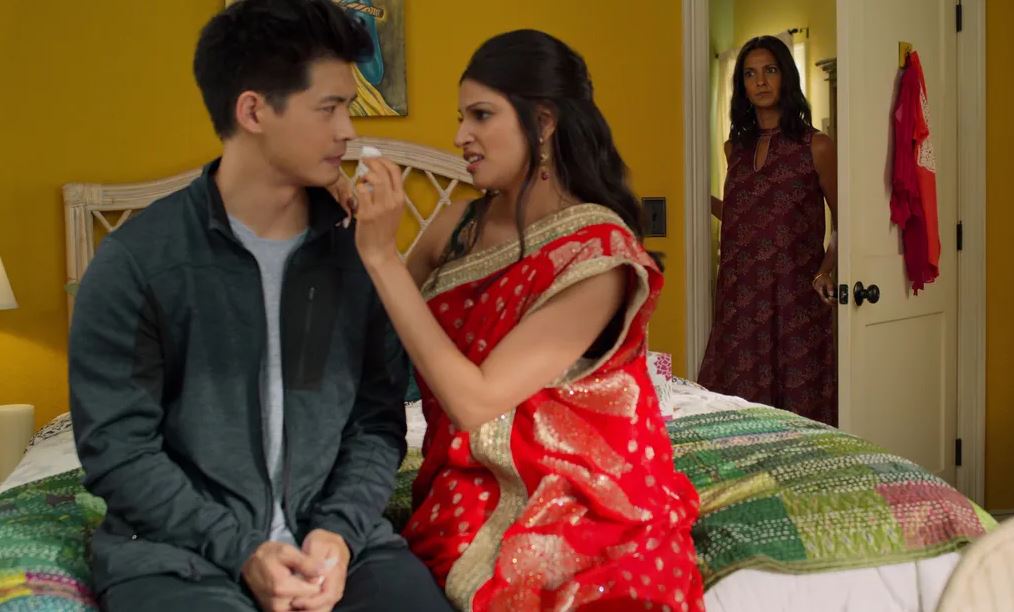By Renee Wang, AsAmNews Staff Writer
An Asian American lead on television and movies is rare. What is even rarer? The portrayal of Asian American couples.
This is occurring despite the backdrop of increased representation of Asian American leads in media. Author Jenny Han, for example, has an Amazon television series and a Netflix movie trilogy based on two of her book series which feature female Asian American leads.
The New Netflix show Partner Track, starring Arden Cho has been described as both a step forward and backward in dealing with Asian American representation. Cho plays Ingrid Yun, a quick-witted senior associate trying to make partners in her law firm. Partner Track, based on the novel by Helen Wan, was intended to portray the barriers Asian American professionals experience in white-dominated workspaces, according to Vox. As both an Asian American woman, Yun represents a group least likely to be promoted into management positions — a phenomenon dubbed the “Bamboo ceiling.”
However, users on social media have critiqued Partner Track for continuing the trope of pairing an Asian female lead with a White male love interest. According to Associate Professor and Chair of Sociology at San Diego State University Minjeong Kim, interracial relationships have been a significant part of Asian American history, owing to the migration patterns of Asian men and women. Anti-immigration laws that limited Asian women from migrating caused many Chinese immigrants to engage in relationships with women outside their race. Then later, Asian women were able to migrate as “war brides” and “mail-order brides.”
“Gina Marchetii’s 1994 book, Yellow Peril, looks at movies that came out in the early and mid-20th century, and even then, all you could see were Asian women with White men, and the underlying message that was delivered was how Asian characters are unassimilable. They are ‘too foreign’ to be incorporated into American society unless they are paired with White characters,” Kim said to AsAmNews. “This idea of ‘forever foreigners’ associated with Asian Americans was reinforced by these images.”
The frequency of the Asian woman and white male pairing, says Professor of Anthropology and Asian American Studies at Northwestern University Shalini Shankar, is also a reflection of male patriarchal power dynamics.
“My feeling [on this pairing] is really a mental vestige of either colonialism or imperialism because that is such a familiar trope from either U.S. conquests in East Asia … or Britsh colonialism in India and the Middle East. There is a longstanding occupation of White men in these countries interacting rightly or improperly with Asian women,” Shankar said to AsAmNews. “That sort of pairing is longstanding: you never see the opposite depicted. We’ve all been socialized to think this is normal. This is the way that the world has been taken over in terms of male patriarchal power dynamics and we haven’t transcended those patterns yet.”
Shankar has also previously participated in a roundtable discussion about the television show Never Have I Ever, created by Mindy Kaling. Never Have I Ever, similar to Partner Track, features an Asian American female lead who has two love interests outside of their race. Although Never Have I Ever includes an Asian female and White male pairing, it does so in several subversive ways, exploring issues of Asian masculinity and caste as well.
Maitreyi Ramakrishnan plays Indian American Devi Vishwakumar in Never Have I Ever. One of her love interests is Paxton Hall-Yoshida, who is of mixed Japanese American heritage. Initially named Paxton Hall, the character was renamed to include actors Darren Barnet’s mixed background. The role has cemented Barnet’s character as what Variety describes as a “teen heartthrob” in his own right.
Asian American men and women have been defined differentially in media in terms of their sexuality, according to Celine Parreñas Shimizu, a filmmaker and Dean of the Division of Arts at the University of California at Santa Cruz. In her book, The Hypersexuality of Race, Shimizu discusses the way media seeks to exclude and represent Asian American sexuality in distorted ways.
(Editor Note: AsAmNews receives a small commission for books purchased through this link. Bookshop.org also supports local independent book stores. )
“Their self-formation is affected by the speaking for Asian Americans that Hollywood enforces … that has excluded them while persisting to represent them in distorted ways: the caricature is exemplified in yellow face representations of the pedophilic Asian man in Broken Blossoms and in the buck-toothed image of Mickey Rooney in Breakfast at Tiffany’s and rapacious Asian men in yellow peril movies,” Shimizu said in an interview over email. “The representations of Asian women are more servile and submissive, catering to a White male fantasy of sexuality that has an edge: it is also untrustworthy and perilous.”
Never Have I Ever also explores other interracial relationships outside the Asian female and White male pairing: Devi’s cousin, Kamala, was in a relationship with Steve, who is of East Asian descent. Kamala eventually breaks up with Steve when she is set up in an arranged marriage with Prashant, a charismatic doctoral engineering student, and the “model minority boyfriend.” In Season 3, the show’s latest season, Kamala decides against marrying Prashant and instead pursues a relationship with high school teacher Manish.
Unlike Prashant, Manish is not an ideal candidate for marriage to Prashant as he is a high school teacher who is not in touch with his Indian culture. According to Himanee Gupta, a Professor of Historical Studies at Empire State College who specializes in South Asian American Studies, the show speaks to the South Asian American experience, and the specific caste and class the Vishiwakumar family are placed in. Gupta, who also participated in the roundtable discussion, says that Devi’s and Kamala’s relationships reveal how caste and the model minority myth set norms for Indian behavior.

“Why was it that these appearances so important?” Gupta said. “Why was Kamala’s failure to accept Prashant, so important — it wasn’t about love or care or compassion, it was what others would think and how it would look to the outside world. How does it affect [their] status in this racialized world?
As Shimizu elaborates, the implications of these representations imposed by others are the way Asian Americans have to contend with their self-image and self-formation as well as physically in everyday life, in coherence and confrontation with the perceptions of others.
Ultimately, while the shows discussed are centered around the love lives of their characters, the romance genre is but limiting in its explorations of Asian American intimacy and sexuality. As explained by Kim, it is easy to dismiss romantic stories as not that serious, but these stories also have a humanizing function.
“When you watch romantic [stories], or people in these storylines, you root for them. You see their vulnerabilities and struggles, which humanizes these characters,” Kim said. “Through these storylines, they become whole people …fuller and more multi-dimensional. Having Asian American characters in these storylines becomes very important.”
In managing stories of representation and their real-life implications for Asian American women, Shimizu points out that Asian American women own their sexualities, even if stories like Partner Track may comply with certain stereotypes. Partner Track and Never Have I Ever, are both shows conceived by Asian women.
“Autonomy is the critical issue in sexuality and for Asian American people, we respond to the hundred-year institution of our representation by systems of representation that have excluded us,” Shimizu said. “Georgia Lee conceived of the show Partner Track based on a book by another Asian American woman. We must remain open to their self-authorships — even if it may look like compliance to stereotype — while remaining aware that we exist in this world where Asian American women are fetishized and spoken for in terms of their desires and sexualities.”

AsAmNews is published by the non-profit, Asian American Media Inc.
Thank you for all those who contributed to our Lunar New Year fundraiser. We exceeded our $5,000 matching grant challenge by 121%! We couldn’t do this without you. It’s never too late to donate. You can make your tax-deductible donations here via credit card, debit card, Apple Pay, Google Pay, PayPal and Venmo. Stock donations and donations via DAFs are also welcomed.
Please also follow us on Instagram, TikTok, Facebook, YouTube and X.


